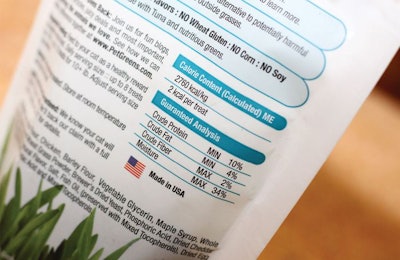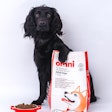
Half of the Pet Food Committee session at the January meeting of the Association of American Feed Control Officials (AAFCO) was spent discussing progress on its pet food labeling modernization efforts. Each of the four subgroups gave a report on what they have been working on and received feedback from the attendees.
Pet Nutrition Facts Box
In an effort to provide nutritional content information more akin to what consumers are used to seeing on their own food labels, a "Pet Nutrition Facts Box" has been proposed. It would replace the current guaranteed analysis and calorie content statement. Visually, it would appear very similar to the Nutrition Facts Box (e.g., table format, black text on white background) but the content wouldn't precisely correlate. Like a human food label, it would provide information on a standardized “per serving” basis (e.g., amounts per cup or can), but the guarantees in terms of percentages or units per kilogram would still be there, too. Calories would be provided on a per serving basis only, but would be further broken down as to contribution of calories from protein, fat and carbohydrates.
Terminology would be simplified; for example, "protein" instead of "crude protein." This causes consternation among those regulators who are concerned that lack of specificity as to the means of testing may result in confusion as to exactly what is being reported on the label. However, provided the required methodology is specified in the regulations, use of more friendly terms on the label itself should be of benefit to consumers and sufficient for regulatory purposes.
Nutritional adequacy/feeding directions
The proposal is to retain the current labeling requirements in terms of a nutritional adequacy statement, but to include mandatory front-of-pack graphics as well. Labels of all complete and balanced pet foods would need to bear a standardized graphic indicating the specified life stage(s) and size(s) for which it is formulated. A unique graphic also has been developed for treats, nutritional supplements and other foods that are not intended to serve as the sole source of nutrition (e.g., toppers), although the proposed language for the graphic ("supplemental feeding") was met with concern by some in the audience. There would be a third graphic for products intended for use under veterinary supervision.
Exact appearance and placement of the appropriate graphic on the principal display panel, as well as minimum size requirements (depending on the area of the panel), would be specified in the regulations. In this way, a consumer can easily identify the product's purpose upon casual review of the front panel as it appears on the shelf, instead of straining to locate the nutritional adequacy statement on the back somewhere.
Ideas with respect to any prospective changes to feeding directions are less developed at this juncture. In addition to other thoughts as to how to improve the directions and for which products feeding directions are needed, there is a concept proposed to require a link to a non-commercial website to provide more information on appropriate feeding practices (e.g., feeding based on body condition scoring).
Ingredients
This may be the most difficult aspect in which to initiate changes, as any alteration may be in direct conflict with existing Food and Drug Administration regulations. For example, one idea is to separate out the vitamins and minerals to better identify them as nutrients as opposed to scary "chemicals." However, that would seriously disrupt the order of predominance of ingredients as mandated by FDA.
Using more simplified but less accurate names of ingredients for the sake of consumer understanding would also be problematic. However, even labeling schemes as currently allowed on human food labels (e.g., "contains one or more of the following" declarations in the case of fat blends or fish-based ingredients) has met with resistance from some regulators. So, the extent to which changes will be made to this aspect of the label remains to be seen.
Other items discussed include renaming some of the more vilified ingredients, such as by-products. However, advances in this area would appear to be more within the purview of the Ingredient Definitions Committee than this group.
Handling instructions
Provisions to require directions for safe handling and feeding of products are being considered. These can be in graphic and/or text form, and unique depending on the type of product (e.g., dry versus canned versus frozen). Due to label space concerns, a link to a non-commercial website to provide more comprehensive instructions is being considered.
Pet Food Committee next steps
Nothing is decided at this juncture. There still is a plan to present these options in the form of a survey and get feedback from consumers and other interested parties before proceeding. Very extensive efforts have been made by many people participating in the various subgroups to get the proposals to their present state. However, much more work will have to be done before implementation of any new regulations can be contemplated.
For more insights by Dr. Dzanis



















